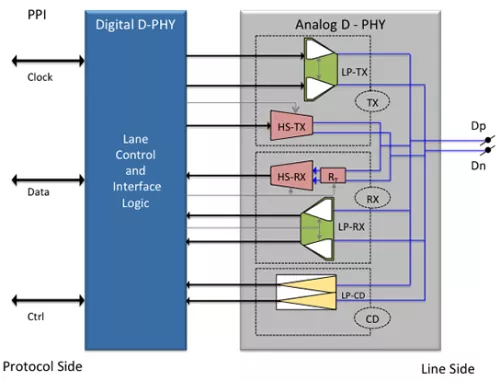The MIPI D-PHY analog IP is available in foundry processes spanning 28nm to 180nm.
The bidirectional MIPI D-PHY Analog Transceiver IP Core is fully compliant to the D-PHY specification version 1.1. It supports the MIPI® Camera Serial Interface (CSI-2) and Display Serial Interface (DSI) protocols. It is a Universal PHY that can be configured as a transmitter, receiver or transceiver. The D-PHY consists of an analog front end to generate and receive the electrical level signals, and a digital back end to control the I/O functions.
The D-PHY provides a point to point connection between master and slave or host and device that comply with a relevant MIPI® standard. A typical configuration consists of a clock lane and 1-4 data lanes. The master/host is primarily the source of data and the slave/device is usually the sink of data. The D-PHY lanes can be configured for unidirectional or bidirectional lane operation, originating at the master and terminating at the slave. It can be configured to operate as a master or as a slave. The D-PHY link supports a high speed (HS) mode for fast data traffic and a low power (LP) mode for control transactions. In HS mode, the low swing differential signal is able to support data transfers from 80 Mbps to 1.5 Gbps. In LP mode all wires operate as a single ended line capable of supporting 10 Mbps asynchronous data communications.
The D-PHY Analog Transceiver IP core implements the PPI interface recommended by the MIPI® working groups to easily interface to the required protocols.
